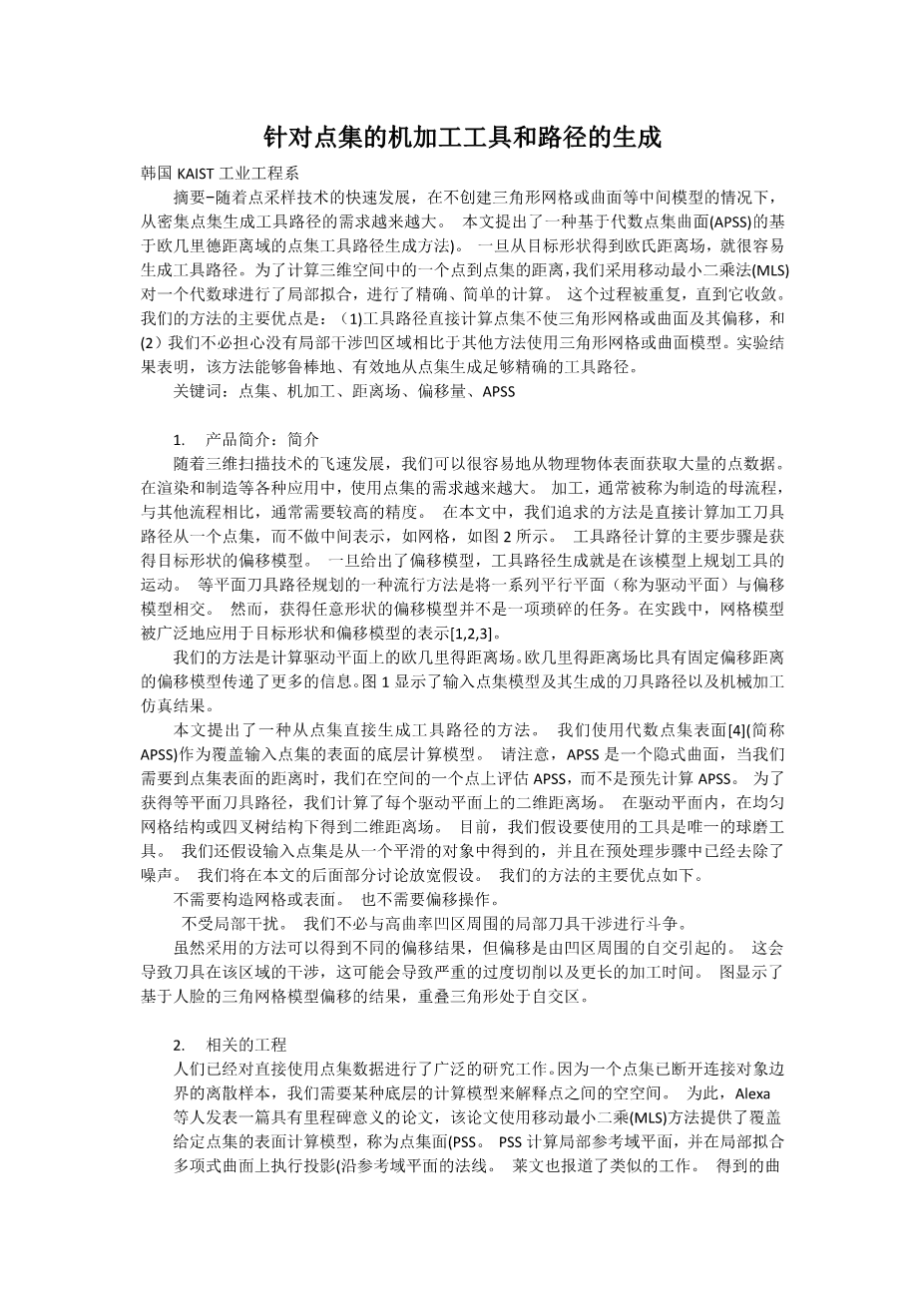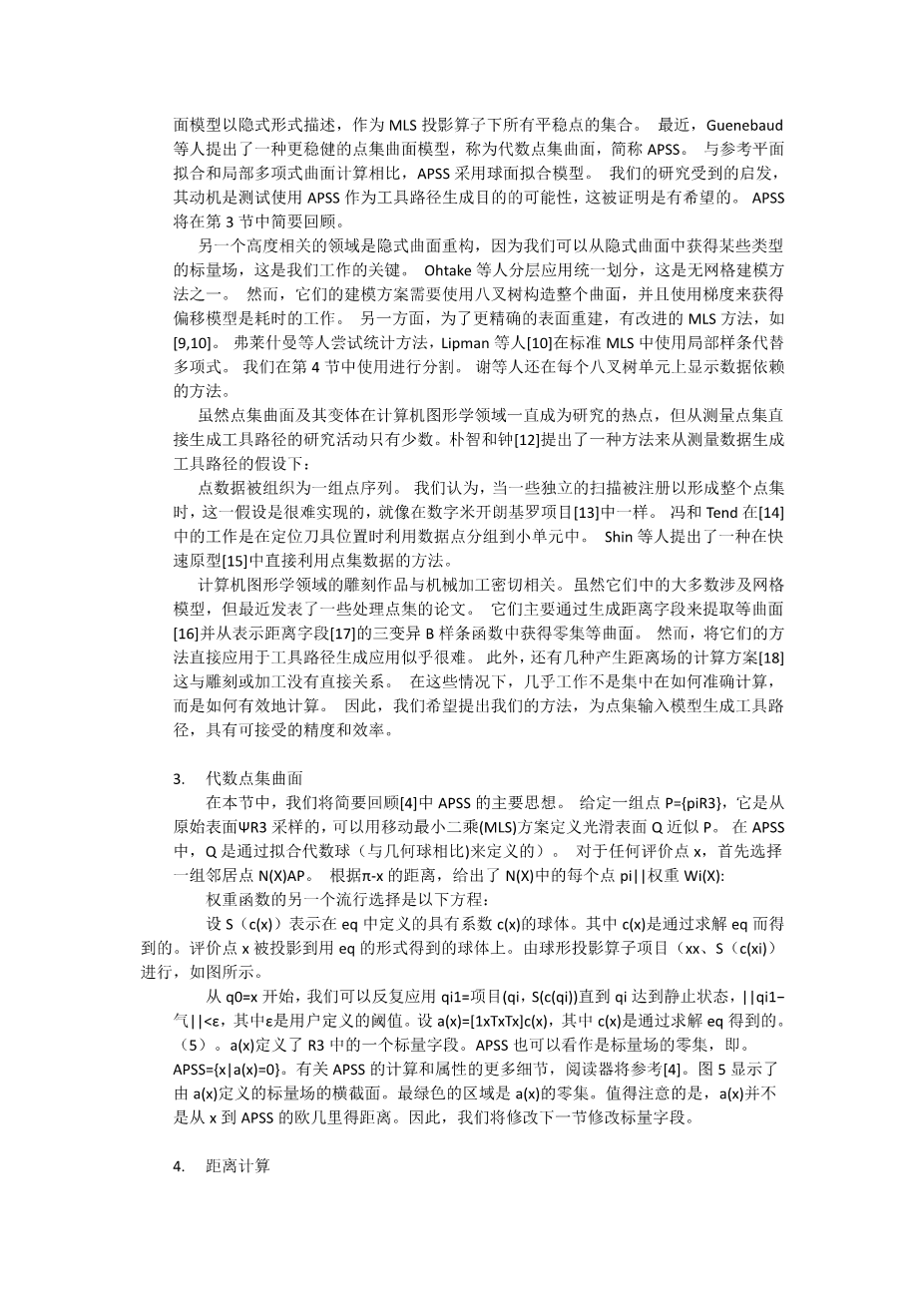International Journal of CAD/CAM Vol. 8, No. 1, pp. 45~53 (2008)
Machining Tool Path Generation for Point Set
Seyoun Park and Hayong Shin*
DAbepstarratcmteminus;ntAosftIhnedpuositnritaslaEmnpgliinnegetreinchg,nKolAogISyTe,vKolovreesarapidly, there has been increasing need in generating tool path from dense point set without creating intermediate models such as triangular meshes or surfaces. In this paper, we present a new tool path generation method from point set using Euclidean distance fields based on Algebraic Point Set Surfaces (APSS). Once an Euclidean distance field from the target shape is obtained, it is fairly easy to generate tool paths. In order to compute the distance from a point in the 3D space to the point set, we locally fit an algebraic sphere using moving least square method (MLS) for accurate and simple calculation. This process is repeated until it converges. The main advantages of our approach are : (1) tool paths are computed directly from point set without making triangular mesh or surfaces and their offsets, and
- we do not have to worry about no local interference at concave region compared to the other methods using triangular mesh or surface model. Experimental results show that our approach can generate accurate enough tool paths from a point set in a robust manner and efficiently.
Keywords: Point set, machining, distance field, offset, APSS
Introduction
With the rapid development in 3D scanning technology, we can easily obtain a large amount of point data sampled from the surface of physical objects. There have been increasing needs of using point set in various applications such as rendering and manufacturing. Machining, often called a mother process for manufacturing, generally requires high accuracy compared to other processes. In this paper, we pursue the method of computing machining tool paths directly from a point set without making intermediate representations such as meshes, as shown in Figure 2. The major step in tool path computation is to obtain an offset model of the target shape. Once the offset model is given, tool path generation is to plan the tool movement on that model. A popular method of iso- planar tool path planning is to intersect a series of parallel planes, called driving plane, with the offset model. However, obtaining offset model of an arbitrary shape is not a trivial task. In practice, mesh model is widely used for the target shape and offset model representation [1,2,3].
Our approach is to compute Euclidean distance fields
on the driving planes, instead. Euclidean distance field conveys more information than the offset model with the fixed offset distance. Figure 1 shows the input point set model and the tool paths generated from it along with the machining simulation results.
In this paper, we present a direct tool path generation
*Corresponding author:
Tel: 82-(0)42-350-3124
Fax: 82-(0)42-350-3110
E-mail: hyshin@kaist.ac.kr / Homepage: http://ieserver4.kaist.ac.kr/
method from point sets. We use Algebraic Point Set Surfaces [4] (APSS for short) as the underlying computational model for the surface covering the input point set. Note that APSS is an implicit surface, and instead of pre-computation of APSS, we evaluate APSS at a point in space whenever we need the distance to the point set surface. In order to obtain iso-planar tool paths, we compute 2D distance field on each driving plane. Within a driving plane, the 2D distance field is obtained at either a uniform grid structure or quadtree structure. For the moment, we assume that the tool to be used is the only ball-end milling tool. We also assume that the input point set is obtained from a smooth object and the noise has been removed in the preprocessing step. We will discuss about relaxing the assumption in the later part of this paper. The main advantages of our approach are as below.
. No need to construct mesh or surface. No offset
operation is required either.
. Local interference free. We do not have to struggle with the local cutter interference around high curvature concave region.
Though the offset results can be different by applied methods, the offset is suffered by self-intersection around concave region[5]. This causes cutter interferences at that region which may make the serious overcuts as well as longer machining time. Figure 3(a) shows the result of face-based offsetting with triangular mesh model, and overlapped triangles are in self-intersected region.
Related Works
There have been extensive research efforts on the direct use of point set data. Since a point set is disconnected
Fig. 1. Mold model 1; (a) the point set sampled from CAD model; (b) semi-finish tool paths (offset distance: 6.0mm); (c) cutting simulation of (b); (d) finish tool paths (offset distance: 2.0mm); (e) cutting simulation of (d).
Fig. 2. Overall procedure.
Fig. 3. Local interferences by self-intersected region; (a) Self- intersections in face-based offset; (b) self-intersection of line segments in 2D. Black line segments are original ones, and the upper grey curve is offset curve. The orange arrows show offset direction.
discrete sample of the object boundary, we need some kind of underlying computational model to interpret the empty space between points. For this purpose, Alexa et al [6] published a landmark paper which provides computational model of the surface covering given point
剩余内容已隐藏,支付完成后下载完整资料


英语译文共 5 页,剩余内容已隐藏,支付完成后下载完整资料
资料编号:[606182],资料为PDF文档或Word文档,PDF文档可免费转换为Word
课题毕业论文、文献综述、任务书、外文翻译、程序设计、图纸设计等资料可联系客服协助查找。


